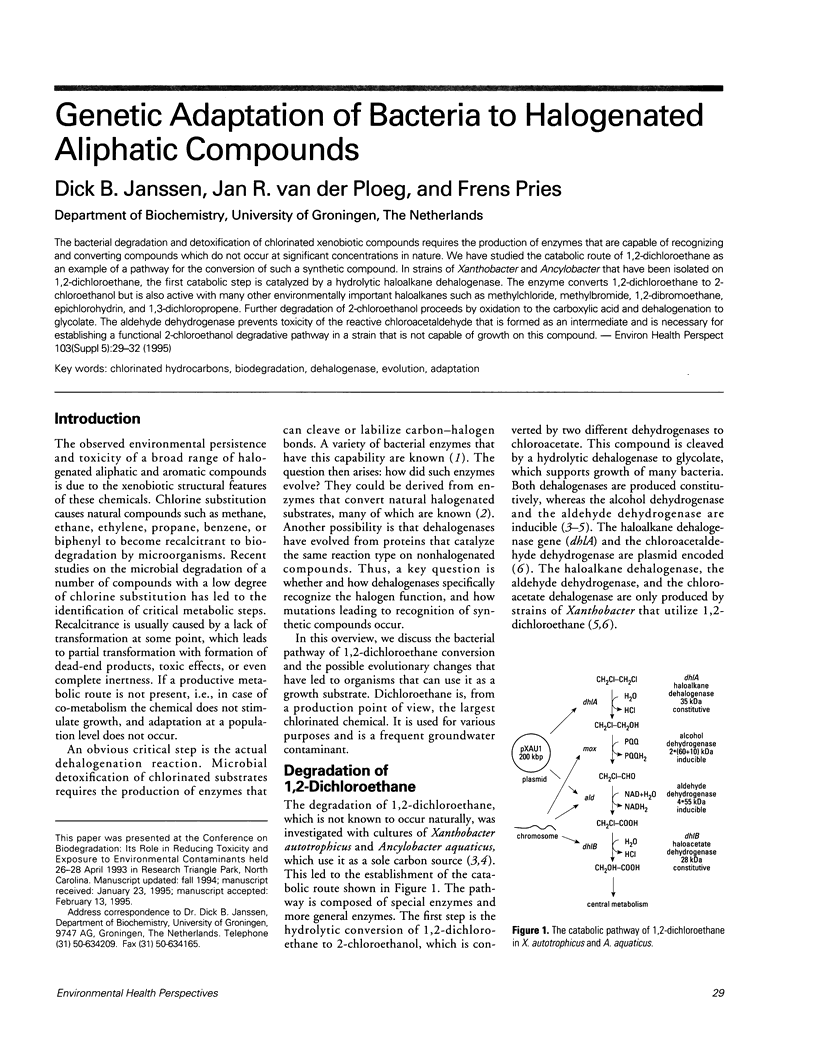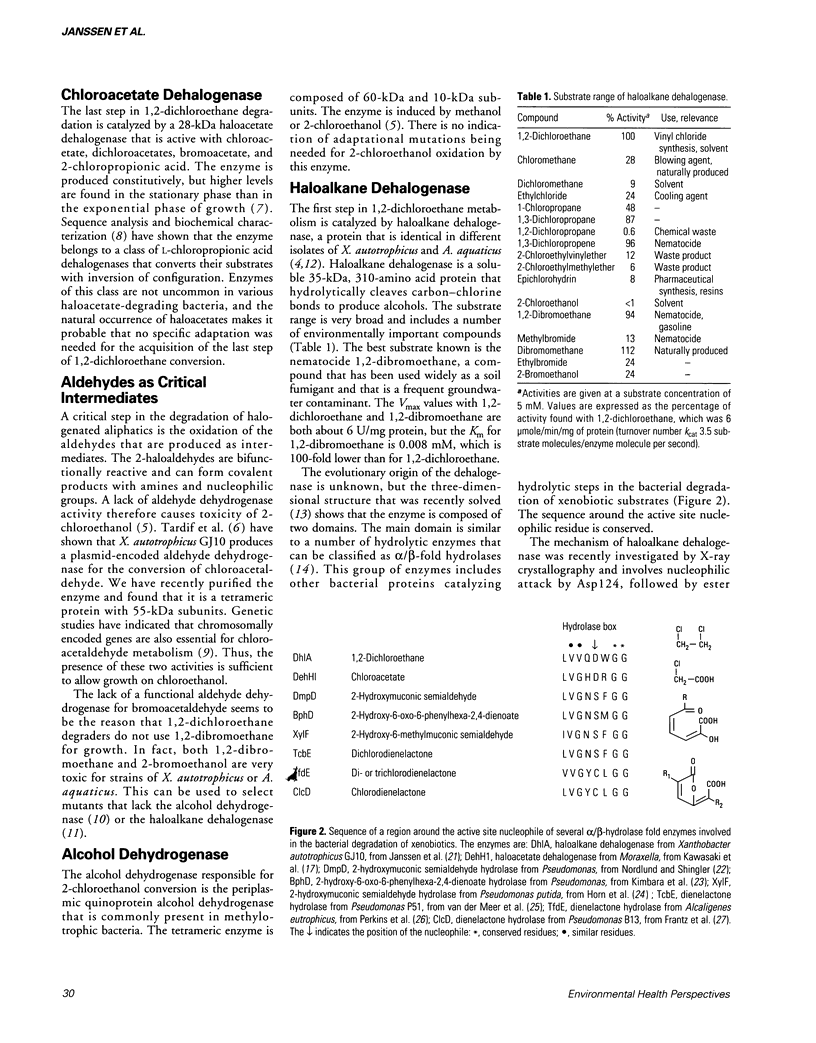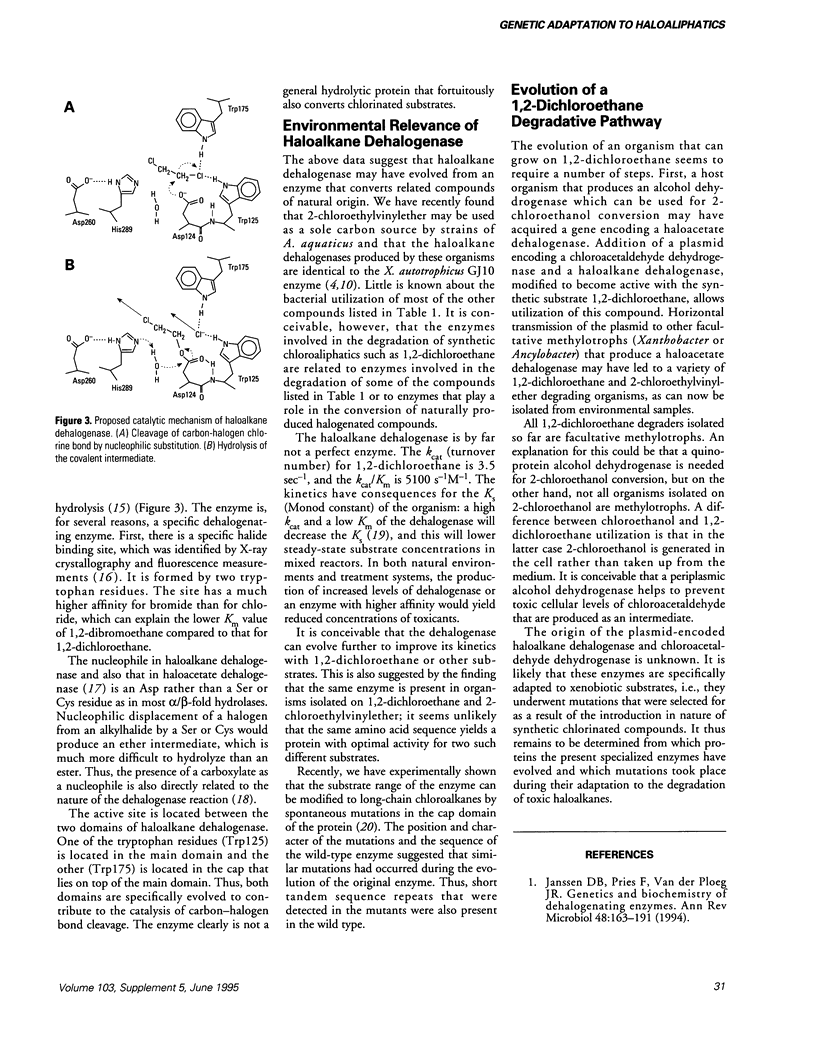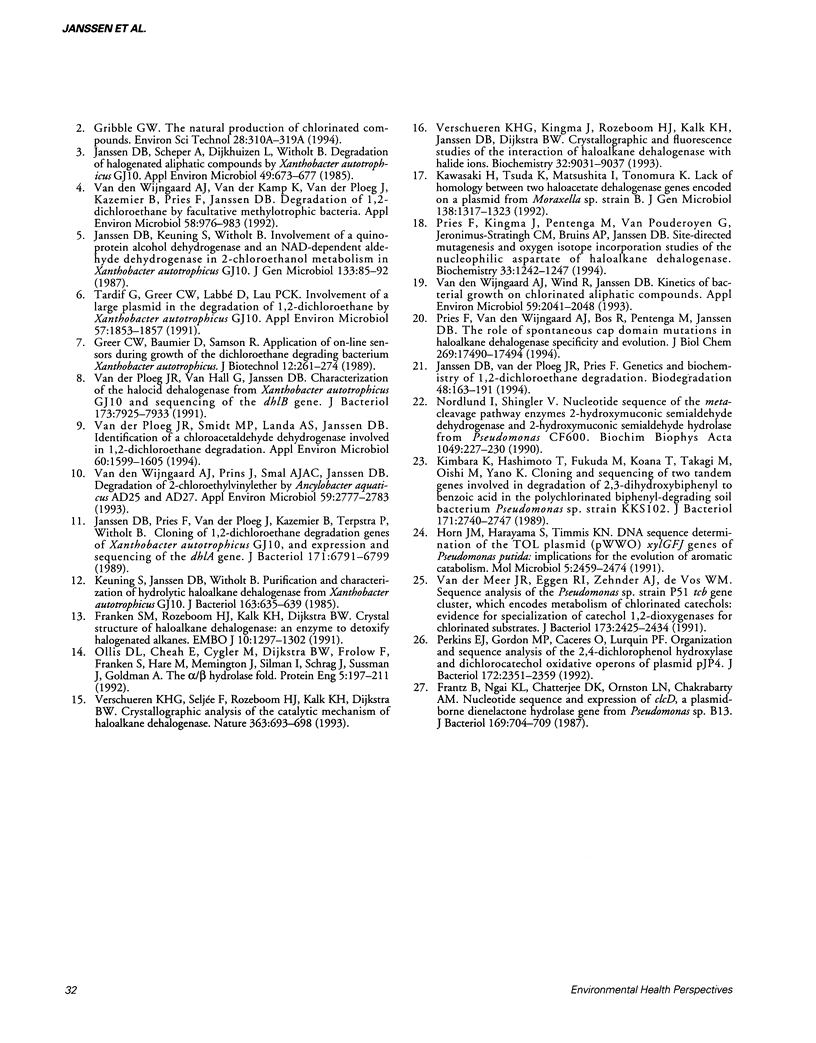Abstract
The bacterial degradation and detoxification of chlorinated xenobiotic compounds requires the production of enzymes that are capable of recognizing and converting compounds which do not occur at significant concentrations in nature. We have studied the catabolic route of 1,2-dichloroethane as an example of a pathway for the conversion of such a synthetic compound. In strains of Xanthobacter and Ancylobacter that have been isolated on 1,2-dichloroethane, the first catabolic step is catalyzed by a hydrolytic haloalkane dehalogenase. The enzyme converts 1,2-dichloroethane to 2-chloroethanol but is also active with many other environmentally important haloalkanes such as methylchloride, methylbromide, 1,2-dibromoethane, epichlorohydrin, and 1,3-dichloropropene. Further degradation of 2-chloroethanol proceeds by oxidation to the carboxylic acid and dehalogenation to glycolate. The aldehyde dehydrogenase prevents toxicity of the reactive chloroacetaldehyde that is formed as an intermediate and is necessary for establishing a functional 2-chloroethanol degradative pathway in a strain that is not capable of growth on this compound.
Full text
PDF



Selected References
These references are in PubMed. This may not be the complete list of references from this article.
- Franken S. M., Rozeboom H. J., Kalk K. H., Dijkstra B. W. Crystal structure of haloalkane dehalogenase: an enzyme to detoxify halogenated alkanes. EMBO J. 1991 Jun;10(6):1297–1302. doi: 10.1002/j.1460-2075.1991.tb07647.x. [DOI] [PMC free article] [PubMed] [Google Scholar]
- Frantz B., Ngai K. L., Chatterjee D. K., Ornston L. N., Chakrabarty A. M. Nucleotide sequence and expression of clcD, a plasmid-borne dienelactone hydrolase gene from Pseudomonas sp. strain B13. J Bacteriol. 1987 Feb;169(2):704–709. doi: 10.1128/jb.169.2.704-709.1987. [DOI] [PMC free article] [PubMed] [Google Scholar]
- Horn J. M., Harayama S., Timmis K. N. DNA sequence determination of the TOL plasmid (pWWO) xylGFJ genes of Pseudomonas putida: implications for the evolution of aromatic catabolism. Mol Microbiol. 1991 Oct;5(10):2459–2474. doi: 10.1111/j.1365-2958.1991.tb02091.x. [DOI] [PubMed] [Google Scholar]
- Janssen D. B., Pries F., van der Ploeg J. R. Genetics and biochemistry of dehalogenating enzymes. Annu Rev Microbiol. 1994;48:163–191. doi: 10.1146/annurev.mi.48.100194.001115. [DOI] [PubMed] [Google Scholar]
- Janssen D. B., Pries F., van der Ploeg J., Kazemier B., Terpstra P., Witholt B. Cloning of 1,2-dichloroethane degradation genes of Xanthobacter autotrophicus GJ10 and expression and sequencing of the dhlA gene. J Bacteriol. 1989 Dec;171(12):6791–6799. doi: 10.1128/jb.171.12.6791-6799.1989. [DOI] [PMC free article] [PubMed] [Google Scholar]
- Janssen D. B., Scheper A., Dijkhuizen L., Witholt B. Degradation of halogenated aliphatic compounds by Xanthobacter autotrophicus GJ10. Appl Environ Microbiol. 1985 Mar;49(3):673–677. doi: 10.1128/aem.49.3.673-677.1985. [DOI] [PMC free article] [PubMed] [Google Scholar]
- Kawasaki H., Tsuda K., Matsushita I., Tonomura K. Lack of homology between two haloacetate dehalogenase genes encoded on a plasmid from Moraxella sp. strain B. J Gen Microbiol. 1992 Jul;138(7):1317–1323. doi: 10.1099/00221287-138-7-1317. [DOI] [PubMed] [Google Scholar]
- Keuning S., Janssen D. B., Witholt B. Purification and characterization of hydrolytic haloalkane dehalogenase from Xanthobacter autotrophicus GJ10. J Bacteriol. 1985 Aug;163(2):635–639. doi: 10.1128/jb.163.2.635-639.1985. [DOI] [PMC free article] [PubMed] [Google Scholar]
- Kimbara K., Hashimoto T., Fukuda M., Koana T., Takagi M., Oishi M., Yano K. Cloning and sequencing of two tandem genes involved in degradation of 2,3-dihydroxybiphenyl to benzoic acid in the polychlorinated biphenyl-degrading soil bacterium Pseudomonas sp. strain KKS102. J Bacteriol. 1989 May;171(5):2740–2747. doi: 10.1128/jb.171.5.2740-2747.1989. [DOI] [PMC free article] [PubMed] [Google Scholar]
- Nordlund I., Shingler V. Nucleotide sequences of the meta-cleavage pathway enzymes 2-hydroxymuconic semialdehyde dehydrogenase and 2-hydroxymuconic semialdehyde hydrolase from Pseudomonas CF600. Biochim Biophys Acta. 1990 Jun 21;1049(2):227–230. doi: 10.1016/0167-4781(90)90046-5. [DOI] [PubMed] [Google Scholar]
- Ollis D. L., Cheah E., Cygler M., Dijkstra B., Frolow F., Franken S. M., Harel M., Remington S. J., Silman I., Schrag J. The alpha/beta hydrolase fold. Protein Eng. 1992 Apr;5(3):197–211. doi: 10.1093/protein/5.3.197. [DOI] [PubMed] [Google Scholar]
- Perkins E. J., Gordon M. P., Caceres O., Lurquin P. F. Organization and sequence analysis of the 2,4-dichlorophenol hydroxylase and dichlorocatechol oxidative operons of plasmid pJP4. J Bacteriol. 1990 May;172(5):2351–2359. doi: 10.1128/jb.172.5.2351-2359.1990. [DOI] [PMC free article] [PubMed] [Google Scholar]
- Pries F., Kingma J., Pentenga M., van Pouderoyen G., Jeronimus-Stratingh C. M., Bruins A. P., Janssen D. B. Site-directed mutagenesis and oxygen isotope incorporation studies of the nucleophilic aspartate of haloalkane dehalogenase. Biochemistry. 1994 Feb 8;33(5):1242–1247. doi: 10.1021/bi00171a026. [DOI] [PubMed] [Google Scholar]
- Pries F., van den Wijngaard A. J., Bos R., Pentenga M., Janssen D. B. The role of spontaneous cap domain mutations in haloalkane dehalogenase specificity and evolution. J Biol Chem. 1994 Jul 1;269(26):17490–17494. [PubMed] [Google Scholar]
- Tardif G., Greer C. W., Labbé D., Lau P. C. Involvement of a large plasmid in the degradation of 1,2-dichloroethane by Xanthobacter autotrophicus. Appl Environ Microbiol. 1991 Jun;57(6):1853–1857. doi: 10.1128/aem.57.6.1853-1857.1991. [DOI] [PMC free article] [PubMed] [Google Scholar]
- Verschueren K. H., Kingma J., Rozeboom H. J., Kalk K. H., Janssen D. B., Dijkstra B. W. Crystallographic and fluorescence studies of the interaction of haloalkane dehalogenase with halide ions. Studies with halide compounds reveal a halide binding site in the active site. Biochemistry. 1993 Sep 7;32(35):9031–9037. doi: 10.1021/bi00086a008. [DOI] [PubMed] [Google Scholar]
- Verschueren K. H., Seljée F., Rozeboom H. J., Kalk K. H., Dijkstra B. W. Crystallographic analysis of the catalytic mechanism of haloalkane dehalogenase. Nature. 1993 Jun 24;363(6431):693–698. doi: 10.1038/363693a0. [DOI] [PubMed] [Google Scholar]
- van den Wijngaard A. J., Prins J., Smal A. J., Janssen D. B. Degradation of 2-Chloroethylvinylether by Ancylobacter aquaticus AD25 and AD27. Appl Environ Microbiol. 1993 Sep;59(9):2777–2783. doi: 10.1128/aem.59.9.2777-2783.1993. [DOI] [PMC free article] [PubMed] [Google Scholar]
- van den Wijngaard A. J., Wind R. D., Janssen D. B. Kinetics of bacterial growth on chlorinated aliphatic compounds. Appl Environ Microbiol. 1993 Jul;59(7):2041–2048. doi: 10.1128/aem.59.7.2041-2048.1993. [DOI] [PMC free article] [PubMed] [Google Scholar]
- van den Wijngaard A. J., van der Kamp K. W., van der Ploeg J., Pries F., Kazemier B., Janssen D. B. Degradation of 1,2-dichloroethane by Ancylobacter aquaticus and other facultative methylotrophs. Appl Environ Microbiol. 1992 Mar;58(3):976–983. doi: 10.1128/aem.58.3.976-983.1992. [DOI] [PMC free article] [PubMed] [Google Scholar]
- van der Meer J. R., Eggen R. I., Zehnder A. J., de Vos W. M. Sequence analysis of the Pseudomonas sp. strain P51 tcb gene cluster, which encodes metabolism of chlorinated catechols: evidence for specialization of catechol 1,2-dioxygenases for chlorinated substrates. J Bacteriol. 1991 Apr;173(8):2425–2434. doi: 10.1128/jb.173.8.2425-2434.1991. [DOI] [PMC free article] [PubMed] [Google Scholar]
- van der Ploeg J., Smidt M. P., Landa A. S., Janssen D. B. Identification of chloroacetaldehyde dehydrogenase involved in 1,2-dichloroethane degradation. Appl Environ Microbiol. 1994 May;60(5):1599–1605. doi: 10.1128/aem.60.5.1599-1605.1994. [DOI] [PMC free article] [PubMed] [Google Scholar]
- van der Ploeg J., van Hall G., Janssen D. B. Characterization of the haloacid dehalogenase from Xanthobacter autotrophicus GJ10 and sequencing of the dhlB gene. J Bacteriol. 1991 Dec;173(24):7925–7933. doi: 10.1128/jb.173.24.7925-7933.1991. [DOI] [PMC free article] [PubMed] [Google Scholar]


